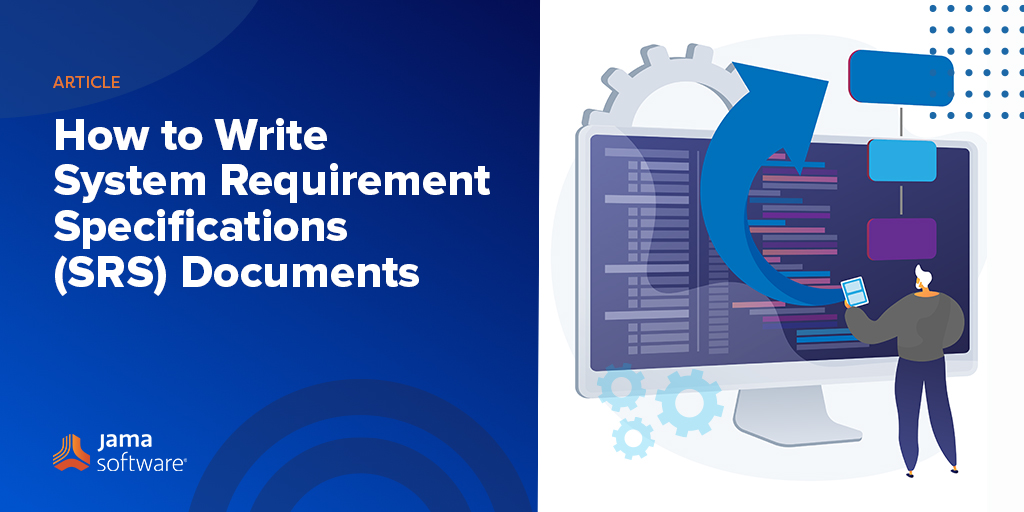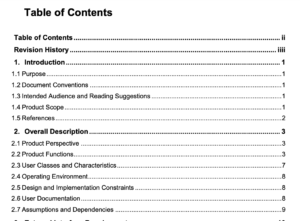Imagine that you’re in charge of designing a 17-story building—but the blueprints are missing. Moving forward without this essential document would put the entire project at risk for serious errors. Launching a new software project is similar in that without a blueprint, you’ll likely produce a system that lacks the necessary software functionality and isn’t aligned with the customer’s needs. Clear requirements, such as those included in a system requirement specifications (SRS) document, create a foundation that ensures your team delivers the right product and avoids expensive reworks.
But where should you start? In this article, we’ll explain details about SRS documents and how to use them, and we’ll provide examples to get you on the path to success.
What is a System Requirements Specification (SRS) Document?
The SRS document is focused on what the software needs to do and how it must perform. It lays the important groundwork so that every person involved with the project understands the most crucial details.
An SRS document outlines the behaviors, functions, and capabilities required of the system, along with any potential constraints. Functional and nonfunctional requirements are included. Design suggestions and information outside the customer’s requirements are not included.
Approval is received from all necessary stakeholders, showing that they clearly understand the project requirements and everyone agrees. In a sense, the SRS document functions as an insurance policy that any party can refer to in case of uncertainty.
Why Use SRS Documents?
Using an SRS document ensures that specifics around a project are crystal clear, mitigating the risk of wasted time and potential reworks. Important benefits of using this type of document include:
- Providing Valuable Customer Feedback. An SRS document is the customer’s confirmation that your organization understands the problems that need to be solved and how the software must behave to address the challenges. Visuals such as charts and tables can provide additional clarity.
- Breaking Work Into Smaller Pieces. SRS documents contain a large amount of information, but they ultimately break problems into smaller, more manageable parts.
- Serving as a Parent Document. The SRS serves as a parent document to any additional documents that follow its creation. The scope of work, software design specifications and other documents often leverage what is highlighted in the SRS document. Plus, it can serve as a product validation check. Did we do it right? Check the SRS document.
The SRS document assists with identifying problems earlier in the development process, which helps manage time more effectively. It’s far easier, for example, to update specifications before any development has begun, versus later in the process.
SRS Document Format: How is a System Requirements Specification Document Written?
Similar to following a recipe, there are several important components, or ingredients, in an SRS document. A good document needs to answer a few critical questions, such as:
- What should the software do?
- How should it behave?
- What are the performance requirements?
- Are there any constraints that need to be noted? And if so, what are they?
A good starting point is an SRS outline. A rough outline of the various sections can help you get ready to fill in the important details. Consider the following:
- Create an Introduction. The introduction addresses what the software needs to do (and what it should not do). The development team and product owners should be involved in writing this part of the plan. Why does the product need to be built? What challenges does it solve? And who is going to use the product? Additionally, the SRS introduction might contain an overview of what is included within the document.
- Write a General Description. Focus on the functionality of the product. Define the required hardware and user interfaces. What do end users expect the software to do? What are the various functionalities? Ultimately, this section will focus on system interfaces, user interfaces, hardware interfaces, software interfaces and more. Additionally, any important assumptions need to be included.
- Include Specific Requirement Specifications. This section examines specific details about the product so it’s easier to design and validate that it has met requirements. It describes all inputs that the software must handle, highlights any required outcomes and clearly defines any necessary integrations. Performance criteria should also be included, as well as any software system attributes, such as readability, availability, security, profitability and more.
Once you have the basic outline, you can start filling it out with the help of your team and client. Upon completion, get final approval. Everyone important to the project needs to review and approve the final version of the document.
Requirement specifications included with the SRS document are diverse, so there isn’t a one-size-fits-all template. However, a general software requirements template such as this one can be used to create the “bones” of your document. You can then fill in the details as you go.
What Should Not be Included in a System Requirements Specification Document?
As you become more experienced at writing SRS documents, the process will become much faster. However, in the beginning, it helps to have a list of common mistakes to avoid. Consider the following:
- Failing to Include a Complete Dictionary. Does your SRS document include jargon that only people in a specific industry understand? If so, create a dictionary section for easy viewing and include definitions of any terms not commonly understood.
- Creating Confusion by Mixing Concepts. Keep your document organized and be careful to present information to readers in a logical flow. Avoid mixing concepts throughout the document so that you don’t create confusion.
- Not Fully Understanding the End User. Who will interact with the software, and what are the expected results? For example, imagine that a software is supposed to generate reports. Part of the requirements address how the user will click on a specific button to generate various reports. Ensure that you know what is expected from the report generation software, but also know who is clicking on that button so you better understand the user and the required functionality.
- Being Too Ambiguous. Ensure that your requirements don’t lead to unclear interpretation. An SRS document is designed to prevent misunderstanding, so make sure the document doesn’t generate it. For every functionality or situation description, make sure that you don’t present specifications that haven’t been defined yet.
How Can Software Streamline the Creation of SRS Documents?
Resources that assist with simplifying requirement specifications are helpful in writing your SRS document. For example, Jama Connect is a hub designed to follow your complete product development life cycle, enabling product managers and engineers to track requirements, decisions, and relationships on multiple levels and deliver compliant, market-driven products effectively.
Jama Connect helps teams deliver high-quality products on time and on budget by aligning stakeholders, identifying risks early on, and visualizing connections between regulations, requirements, and test cases throughout the development process. If you’re looking for a solution to simplify writing SRS documents, ensure that it provides:
- Confidence. Traceability requirements should be apparent throughout the entire development process, illuminating risk and allowing you to proceed with confidence.
- Visibility. The solution should offer visibility into the product development process by monitoring relationships and dependencies between systems, teams, activities and results.
- Speed. Speedy alignment should be provided, which assists with tracking decisions, increasing efficiency and minimizing reworking to create high-quality products on time and on budget.
- Adaptability. Make sure the solution easily adapts to your organization’s workflows, creating an intuitive experience for your teams to get up to speed fast.
- Performance. Ensure the system provides benchmarks and monitors team performance over time to better understand the benefits of retooling your product development process.
Overall, you want to make sure that any software that assists with streamlining the creation of SRS documents equips your team with the ability to analyze impacts, track decisions and ensure the quality of the product you set out to build.
Moving Forward With Greater Success
Designing a robust SRS document ensures that you have a “go to” document for your entire development project. The goal is to smooth out any potential implementation snags prior to the program development process. Yet at the same time, the document needs to be flexible and scalable so that it’s easy to modify with product demands.
Keeping the above tips in mind when writing and reviewing requirements empowers you to create a project that closely aligns with clients’ needs, prevents costly mistakes and ultimately supports you in building better products.
- Strategies for Mitigating Software Defined Vehicle (SDV) Development Risks and Reducing Costly Recalls - November 19, 2024
- The Clear Choice: Why Jama Connect® Surpasses Codebeamer for Requirements Management and End-to-End Traceability - November 12, 2024
- Jama Connect® Receives Buyer’s Choice for 2025 on TrustRadius! - October 30, 2024

